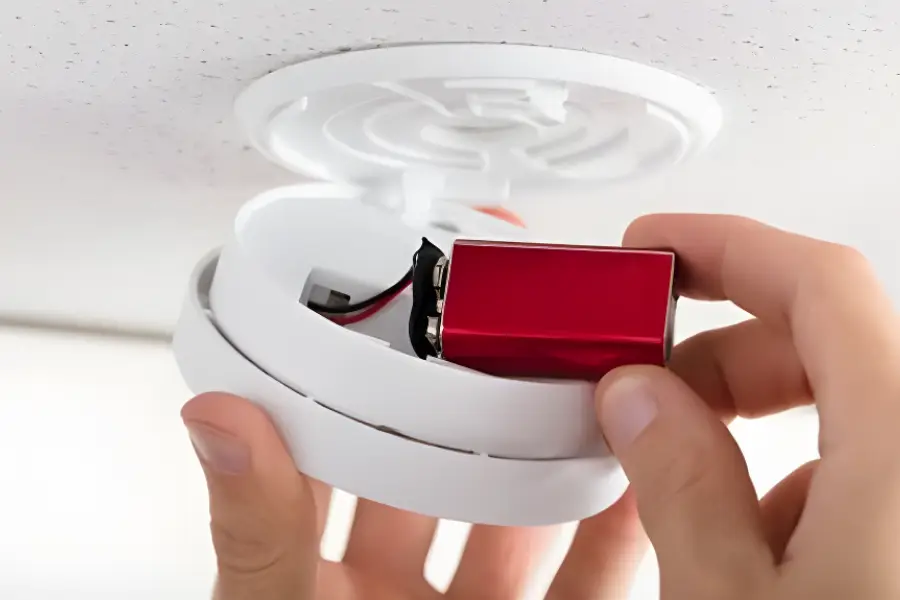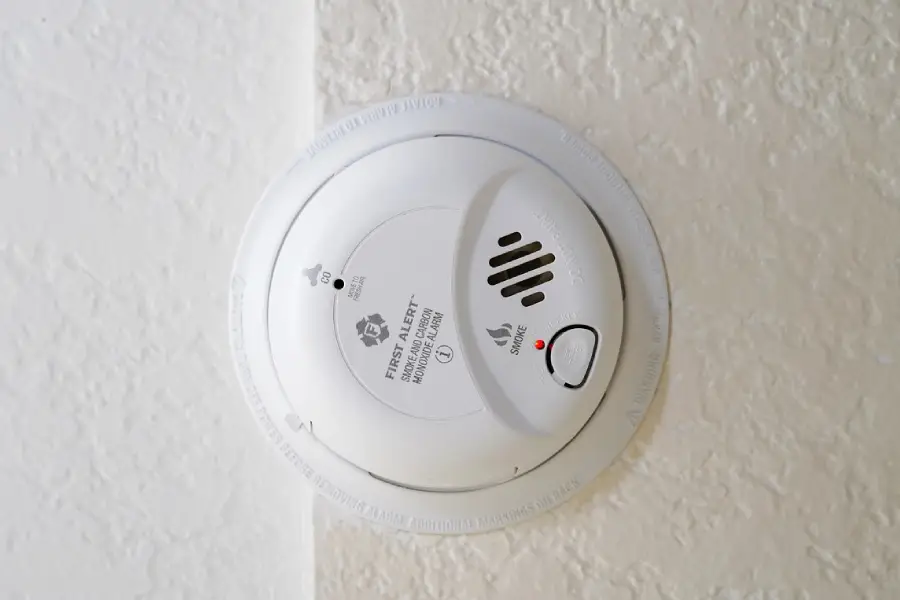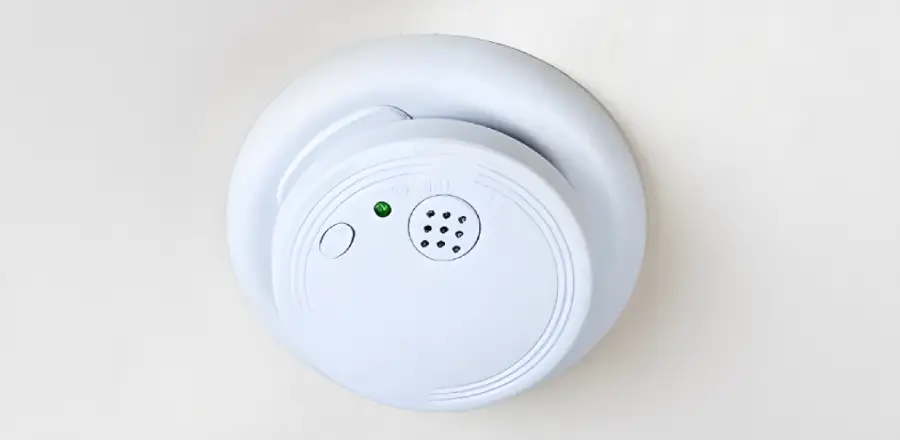Blinking Green Light on Smoke Detector. Have you noticed a blinking green light on your smoke detector and wondered what it means? A blinking light on your smoke detector often indicates that something needs attention. In this article, we’ll explore the common reasons for a blinking green light on a smoke detector and what you need to do when you see this light.
Table of Contents
Blinking Green Light ON Smoke Detector
Seeing a blinking green light on your smoke detector can be confusing and concerning. However, it’s an important indicator that you should pay attention to. The blinking light is trying to communicate something about the status or functioning of your smoke detector. Understanding what a blinking green light signifies can help you resolve any issues promptly and ensure your smoke detector is operating correctly to detect smoke and fire in your home.
A blinking green light on a smoke detector typically signals one of three things:
- The battery is low and needs to be replaced. This is the most common cause of a blinking light.
- There is a fault with the alarm, such as a malfunction or the sensor being blocked. The detector may need cleaning or resetting.
- The smoke detector has reached its expiry date and needs to be replaced with a new unit. Most detectors should be replaced every 8-10 years.
What is that Blinking Green Light?
Before we plunge headfirst into the mysteries surrounding the blinking green light, it’s crucial to understand what a smoke detector is and how it functions. In every household, a smoke detector is a sentinel of safety, continuously monitoring the air for any traces of smoke or fire. When it detects any such danger, it promptly sounds the alarm, potentially saving lives and property.
However, in our quest to understand this blinking green light, we must first grasp the different signals your smoke detector emits. The most common of these signals are the steady green light, which signifies normal operation, and the red light, indicating an issue that needs your attention.
The Steady Green Light
When you observe a steady green light on your smoke detector, it’s the device’s way of letting you know that all is well. The world around you is free from smoke or fire, and your smoke detector is functioning correctly. It’s a reassuring sight, assuring you that your home is protected.
The Red Light
On the other hand, the red light is the alarm signal. When your smoke detector’s light turns red, it’s time to act swiftly and ensure your safety. It means that smoke or fire has been detected, and the alarm may sound any moment. In such a scenario, your immediate response is vital.
Why Smoke Detectors Have Indicator Lights
Smoke detectors contain indicator lights to communicate important information to homeowners. While many detectors just have a simple red blinking light when the battery runs low or the alarm is triggered, more advanced models have multiple lights that convey more specific diagnostic data.
The green light serves as a visual cue that everything is functioning correctly. When the light starts blinking, it signals to the homeowner that attention is required. The diagnostic light provides an early warning of potential issues, allowing the problem to be corrected before the smoke detector stops working properly.
Understanding what the blinking light means quickly tells you whether the detector needs a battery change, cleaning, resetting or replacement. This helps ensure your smoke detector is always ready to detect fires and save lives.
Reasons for a Blinking Green Light on a Smoke Detector
There are three main reasons you may notice a blinking green light on your smoke detector.
Low Battery
The most common reason for a blinking light is a low battery. Smoke detectors are powered by batteries, commonly AA or 9V batteries. When the batteries start to lose power, the green light flashes to indicate this. A low battery should be replaced right away to maintain protection.
Smoke detector batteries should be replaced at least once a year. You can test your battery monthly by pressing the test button on the smoke detector. If you don’t hear the alarm sound, the battery needs to be replaced.
All smoke detectors should emit an audible low battery warning chirp or beep in addition to the blinking light. This alerts you even if you don’t notice the light flashing.

Faulty Alarm
A blinking green light may also indicate an issue or malfunction with the alarm itself. Newer smoke detector models have a self-diagnostic function that monitors the sensor and circuitry. If a fault is detected, the blinking light alerts you to the issue.
Problems that can set off the blinking light include a blocked sensor, defective component or sensor degradation over time. Dust, dirt and dead insects can obstruct the smoke sensor, while electrical issues and wear and tear can impact the alarm system.
If the light blinks due to a defective alarm, you’ll need to clean, reset or replace the unit. Try cleaning the detector and resetting it by holding down the test button for 10-15 seconds. If the blinking light persists, the alarm likely needs replacing.
Expired Unit
Most manufacturers recommend replacing smoke detectors every 8-10 years. The sensors lose sensitivity, components degrade and technology becomes outdated over time. The blinking light on an older smoke detector is a sign that its service life has ended.
Smoke detectors also have a printed replace by date on the back of the unit. Once this date passes, you should install a new detector, even if the old one still seems to be working. An expired smoke detector may fail to detect smoke in the event of a fire.
The blinking light reminds you to swap out detectors that are past their expiry date for new, up-to-date models. This ensures you have reliable, functioning alarms for maximum protection.
Learn more: Tips for First Time Denture Wearers.
What to Do When You See the Blinking Light
When you notice a blinking green light on any of the smoke detectors in your home, take action right away. Here are the steps to take:
- Identify which smoke detector has the blinking light. Check all detectors in case multiple units need attention.
- If the light blinks about once a minute, this indicates a low battery. Replace the batteries in all detectors that have a blinking light. Use new high-quality alkaline batteries.
- After replacing the batteries, test the smoke detectors by pressing the test button until the alarm sounds. This confirms the units are working again after the battery change.
- If replacing the batteries doesn’t stop the blinking light, try cleaning the smoke detectors. Use compressed air or a vacuum crevice tool to remove dust and debris from the sensor openings.
- Next, reset the smoke detectors by holding down the test button for 10-15 seconds. This may clear any faults and stop the blinking light.
- If cleaning and resetting doesn’t work, the smoke detectors likely need to be replaced. Check the replace by date and replace any detectors that are over 8-10 years old.
- When installing new smoke detectors, follow the manufacturer’s instructions. Place detectors in all required rooms and test them monthly.
Taking prompt action when you see a blinking green light allows you to fix any issues before your smoke detectors stop working properly. This ensures your home and family are protected against fire.

Preventing Smoke Detector Issues
While blinking lights on smoke detectors are normal, you can take proactive steps to minimize issues. Here are some tips:
- Change batteries annually – Set a reminder to replace smoke detector batteries every year before they can run down. Use fresh alkaline batteries.
- Clean detectors regularly – Dust and vacuum smoke detectors 2-3 times per year. This prevents dirt and debris from blocking the sensor.
- Avoid false alarms – Don’t place detectors too close to kitchens and bathrooms where steam can set them off. Keep units away from vents as well.
- Install photoelectric detectors – These are less prone to false alarms than ionization models. Dual sensor detectors are optimal.
- Replace detectors every 8-10 years – Don’t wait for lights to blink; just plan to install new units every decade.
- Test detectors monthly – Make it a habit to test all smoke detectors monthly by pressing the button until the alarm sounds.
- Follow manufacturer guidelines – Check the user manual for any specific instructions on cleaning, testing and replacing your model of detector.
With preventive maintenance and regular replacement, you can avoid many blinking light warning signals. But when you do see that blinking green light, take it seriously and determine what your smoke detector is trying to tell you.
Blinking Green Light on Smoke Detector. When you notice a blinking green light on your smoke detector, it’s alerting you to an issue that needs attention. This visual indicator helps homeowners identify and resolve problems before smoke alarms stop functioning properly. Understanding what the light means allows you to quickly take appropriate action.
A blinking light usually signals a low battery, faulty alarm or expired unit that requires replacement. Attending promptly to smoke detectors with blinking lights ensures your home fire safety system is maintained in good working order. With functional smoke alarms, you’ll have the best protection against tragic house fires. So take that blinking green light seriously and let it guide you in keeping your smoke detectors ready to save lives.
FAQs
1. Why is green light blinking on smoke detector?
The green light on a smoke detector blinks to indicate normal operation. It reassures you that the detector is functioning correctly and there are no immediate threats like fire or smoke.
2. Why is my fire alarm beeping with a green light?
A fire alarm beeping with a green light typically means the detector is working properly and hasn’t detected any smoke or fire. It’s a sign of normal operation.
3. Why is my smoke detector flashing green every 16 seconds?
If your smoke detector is flashing green every 16 seconds, it may indicate a low battery or the end of the detector’s lifespan. It’s a signal to replace the battery or the detector itself.
4. Should smoke detectors blink red or green?
Smoke detectors typically blink green during normal operation and turn red when they detect smoke or fire, signaling an alarm.





